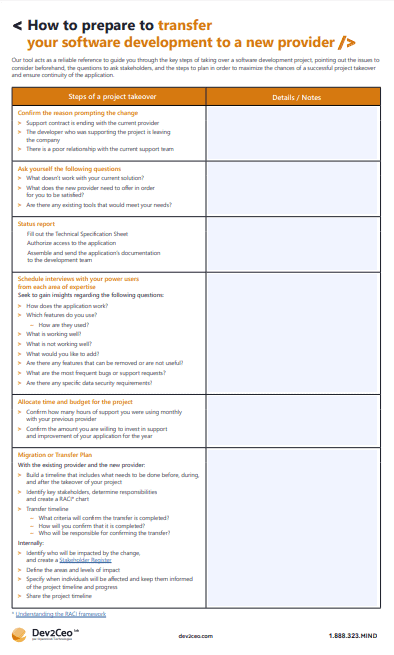Want to hand over your IT project to a new partner with ease ?
Download our free transition plan checklist for handing over your software development to a new partner.

When embarking on a technology project, choosing the right partner is a strategic decision that can have a significant impact on the overall success of your initiative.
To help you navigate this complex process, we’ve compiled a list of 15 essential points to consider when choosing a technology partner.

Clear distinction between software & web development
It’s essential to recognize the distinction between these two disciplines. The development of a custom application requires specific expertise that differs from the creation of a standard website. This difference lies in the required structure, methodology and technical expertise.
In this example, it would be like asking an electrician to do plumbing – the result could be questionable, since it’s not his specialty.

Beware of over-optimistic fixed-price offers
Before committing to a price or timeframe, it’s crucial to carry out a thorough analysis of the project, no matter how complicated the desired IT system. Beware of promises of low costs and fast delivery, as software development always involves risks and challenges to overcome.
It’s important to be aware that the process is not without its pitfalls. Also, be particularly wary of salespeople or lone individuals claiming to be able to manage the whole project from A to Z.

Validate experience & available resources
What’s more, in our various subsidiaries at Openmind, Dev2CEO and Legacy Recoding, we’ve learned that a large-scale project requires a diverse team. Before committing to a partner, make sure they have the necessary experience and resources by having already completed similar projects.
Why is that? Because every specialist, from back-end to front-end, contributes to the success of the project. Don’t entrust a major project to a single individual claiming to do it all.
Make sure your partner has the expertise and resources needed to bring your project to fruition.

Agile vs. Waterfall methodology
Find out more about your partner’s working methodology. Using agile can be beneficial for complex, evolving projects, while the waterfall method may be suitable for projects that are more defined from the outset.
It’s important to choose a methodology that matches the nature of your project, and to ensure that your partner has solid expertise with it.

Clearly defining the mandate
It’s crucial to map out and clearly define the scope from the outset. Too often, contracts are limited to a few lines, which can lead to misunderstandings and frustration.
At Dev2CEO, we recommend ;
Although areas of uncertainty remain, the aim is to reduce them as much as possible to avoid confusion and frustration later on.

Download our free transition plan checklist for handing over your software development to a new partner.


Ability to define user stories
Defining clear user stories and epics is crucial to any software development project. This methodology, an integral part of the agile approach, consists in describing precisely the expected functionalities and objectives of the product. User stories play a central role in describing user needs and what the product should achieve.
A well-defined structure around user stories avoids wasted time and uncertainty, contributing to the overall success of the project.

Ability to offer load testing
Make sure the partner has experience of managing high-volume systems and offers load testing. Check that you’re hosted on a dedicated server, with no other customers likely to have an impact on you.
We’ve already seen cases where sharing the server and code with other clients has caused problems during modifications, compromising the launch.
Be sure your architecture is ready to handle the expected load from day one, to avoid wasting money and effort on further development.

Get recent references
Ask for recent references to assess the quality of the partner’s work and its team. Make sure the references relate to the specific team that will be working on your project, for a more accurate assessment. It’s important to take into account any changes in the team and assess the quality of current work.

Own the code
Make sure contracts clearly state that you are the owner of the code developed with the partner. This avoids legal problems and ensures that you have full rights to the final product. This also includes the possibility of using and modifying the code in the future, without being overly dependent on the original provider.

Capacity to apply agile methodology carefully applied
Agile methodology, when properly applied, delivers significant value to the customer. It involves regular delivery of functionality every two weeks, with fixed prices for each delivery.
This approach creates a dynamic rhythm where the customer knows what to expect, and development teams are accountable for delivering concrete results. However, delays of several months are unacceptable, and it is essential to maintain two-week sprints, even at the start of a project.
Friendly reminder

Handling bugs
Bugs are inevitable in any software development project. It’s important to understand that it’s impossible to eliminate bugs completely, but rather to manage them effectively. Ask your partner about its warranty and bug-fixing policy, as well as its quality assurance structure to ensure the quality of delivered code.

Ability to coach customers
Customer behavior can influence the progress and cost of a technology project. It is essential to make customers aware of behaviors that can lead to delays or budget overruns. An open dialogue between customer and technology partner is necessary to resolve potential problems and keep the project on track.

Don’t reinvent the wheel
If there are systems on the market that meet your needs, evaluate them carefully. Starting with an existing solution allows you to assess sales volume and limit costs. Replicating advanced functionality can be costly and error-prone.
However, be careful when integrating third-party modules, checking their reliability and consulting user feedback. Avoiding reinventing the wheel will save you time, money and frustration.

Propose a maintenance structure

Education & knowledge sharing
Look for a technology partner who promotes education and knowledge sharing with you. A mutual understanding of project objectives and technologies is essential for successful collaboration.
Make sure your partner is transparent in its approach and helps you improve as an organization.
Subscribe to receive our exclusive updates directly to your email.

Takeaway
In conclusion, choosing the right technology partner is crucial to the success of your project. By considering these 15 key points, you’ll be better equipped to evaluate different potential partners and choose the one that best meets your needs and objectives.
Transparency, open communication and mutual understanding are the foundations of successful collaboration.
Take the time to ask questions, do your research and choose wisely, because the right partnership can make all the difference to the success of your technology project.
Tell us more about your needs so that we can better route your project to our specific SWAT team.
1
During the brainstorming phase, we work with you to identify potential solutions to your business challenges to generate the technology response that aligns with your business objectives.
2
Through our requirements gathering process, we work closely with you to define and prioritize your needs, ensuring that our solutions are tailored to meet your specific requirements.
3
This phase marks the beginning of our partnership. We’ll finalize the project plan and establish clear communication channels to ensure a smooth and successful project execution.